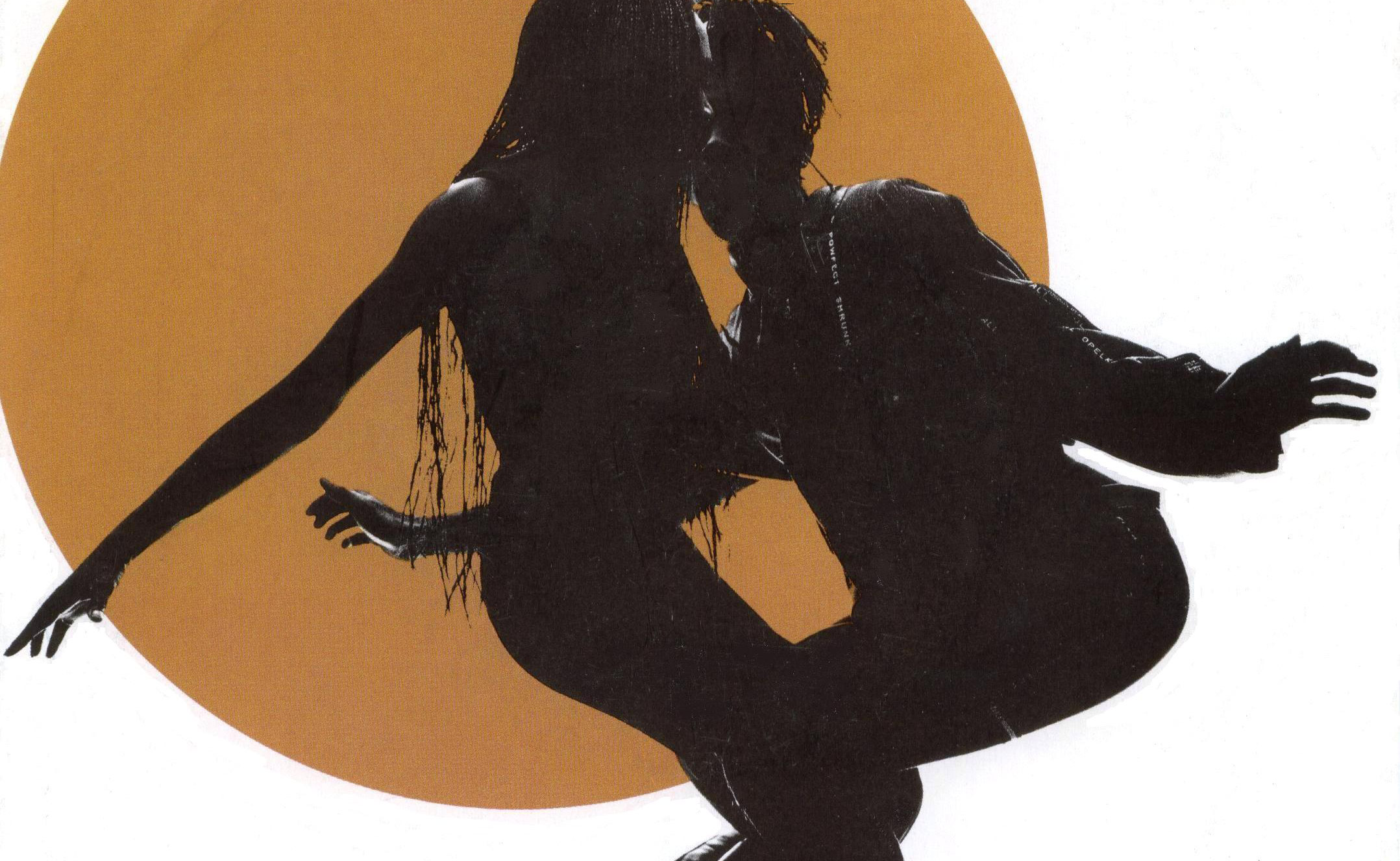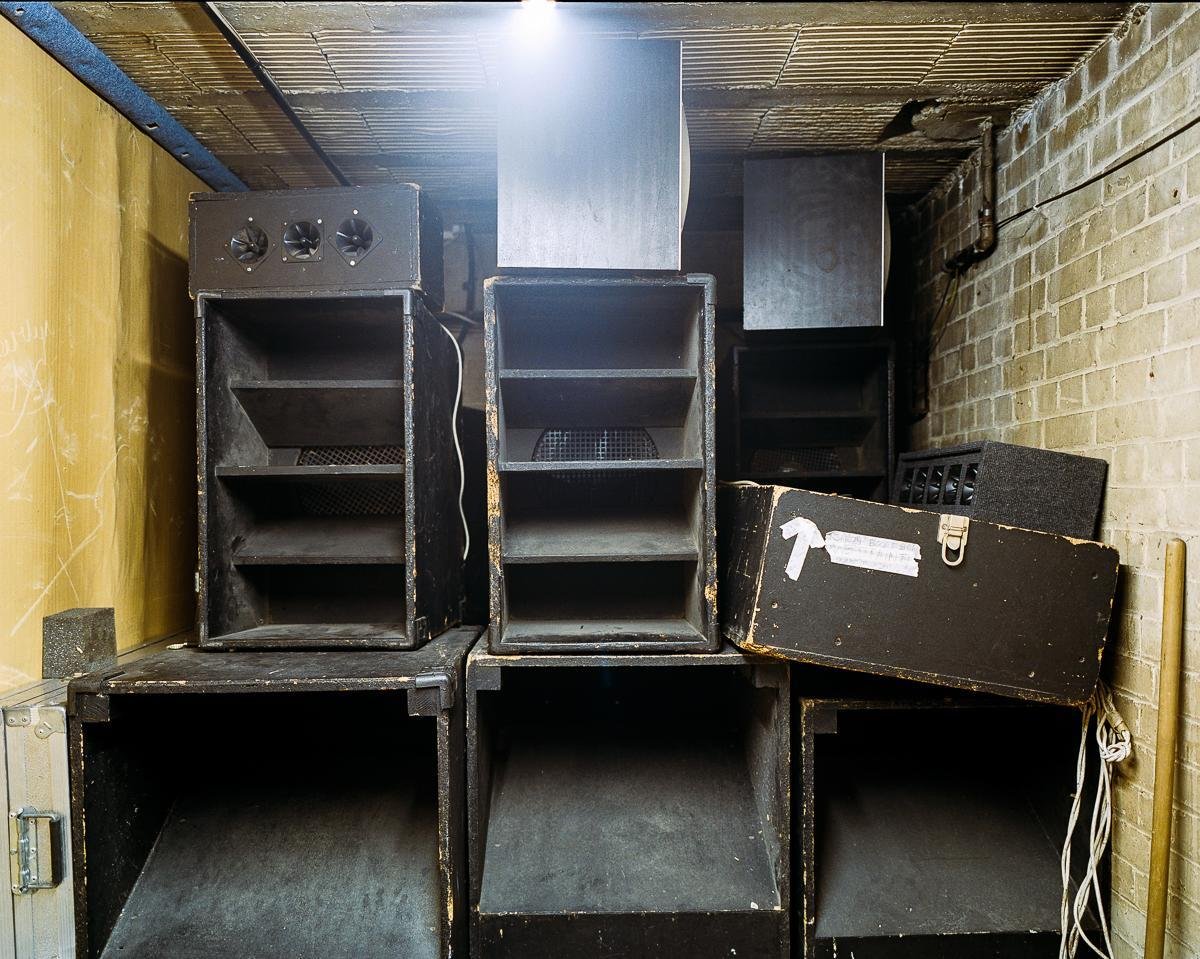Paris’s First Underground Soundsystems
How reggae lovers brought the sound of Jamaica and the UK to the French capital
Didier Vacassin’s instinct was perfectly right, at least in one regard: “I knew we were doing something that had never been done before.” Five mythical evenings at the rue des Panoyaux chapel didn’t exactly go down in music history, but the MC – who went by the name Ras Gugus – had the foresight to document what would be the birth of Parisian soundsystems, lovingly annotating each one of the photographic artifacts he and then-girlfriend Marie Vanetveelde (who passed away in 2008) took over 33 years ago. Today, the fastidiously organized collection can be perused in his apartment, which is lined from floor to ceiling with an equally methodical collection of reggae and dub 45s, competing for scarce square meters with an impressive archive of books and magazines.
From 1985 or 1986 on, France had produced somewhat famous sound crews: Reality, followed by Youthman Unity, Jah Wisdon and Kwamé n’Kruma, which begat relatively more established Gallic raggamuffin acts such Pablo Master, Tonton David and Daddy Yod. But the genesis of this movement can be traced back to Didier and sidekick Papa Ange’s foundational 1983 soundsystem nights in Paris.
Patrick Leygonie (Radio Ivre) and José Jourdain had organized a night out of a community center in suburban Courbevoie back in 1978. In 1979, African and Jamaican-music journalist Hélène Lee had also spearheaded a series of sessions with Jamaica’s Lone Ranger on jazz club Le Duc des Lombards’ meager PA, which heralded a year of toaster/selector sessions in France. But let us be clear – nobody before Vacassin had attempted to assemble the requisite pile of speakers and done so with some consistency in mind.
“Of course, Paris had some soundsystems – well at least, you would hear about them from time to time, in this really informal, underground, quasi-confidential way and not always reliably so,” writes Vacassin on former toaster-turned- computer programmer Bernard Bacos AKA General Burning’s fascinating Paris 70 blog.
“I remember seeing a few posters by Gare du Nord, or in the avenue de Flandre squats, primarily. Thirty or so well-intentioned, if slightly skeptical enthusiasts, packed around a stereo system in a candlelit basement, almost trying to convince themselves that they’re vibing to some novice toaster’s rasta-lite ad-lib. The atmosphere was more early Christian subterranean black mass than soundsystem, to be honest, not to mention that half the time, the whole thing was cancelled and you’d just turn up to a closed door. That 1981-82 era were some fun, random times.”
They say location is key – and in the case of parties, it makes the difference between a night out and a quasi-religious experience. So it was in the 20th arrondissement, in a disused rue des Panoyaux chapel, that the Gugus-Ange duo chose to hold their series of “Reggae Parties.” And to quote Kodjo Asher’s lyrics, as canonized in Daddy Yod’s Il était une fois… Raggamuffin documentary, “Aller en sound, c’était une façon de prier” [“Going to a soundsystem is just another way of praying”]. The Panoyaux soundsystems embodied the sentiment perfectly, with Michael Palmer and Barry Brown 12-inches bouncing around the vaulted arches as curated by a rotation of selectors officiating at the altar. But as off-the-cuff as they seemed, those ceremonials were three whole years in the making.
Rewind to the year 1980, and Bob Marley’s music was the stuff of mainstream. Using an article written by Bruno Blum as part of his reggae column in Best Magazine as a travel guide, Vacassin followed his innate curiosity to London to investigate the scene further. The trip was the culmination of years of perambulations for the 28 year old, who spent his childhood bouncing from the working-class suburb of Garges-lès-Gonesse (where his bookworm leanings socially ostracized him) to summer day camps among the 16th Arrondissement’s well-to-do (where counsellors introduced him to Chuck Berry and The Kinks.)
Dropping out of high school at the first opportunity, Vacassin took a prepress job in a printing plant, which he quit to become a courier – a job so grueling that his colleagues shot up between scooter runs. “I guess you could say I tried every job back then, but it was a good era for that,” he says. “I was relatively happy being mobile – I was good at landing on my feet.” So much so that at the time of the first Panoyaux soundsystem, he was working as a youth group facilitator, less out of vocational fervor than because his girlfriend gave him an in.
Reggae made its way to our outcast bibliophile’s ears in 1977, when France Inter radio legend Patrice Blanc-Francard started caning Max Romeo’s War Inna Babylon album on his show, Bananas. His obsession with the genre became pathological with the discovery of the Gladiators’ 1979 album Proverbial Reggae, with its standout hit “Stick a Bush” on every station’s high rotation list: “That’s when I really started make everyone around me fed up with reggae.” But what about Marley? “I wasn’t such a fan – he was already all over the rock rags at the time,” claims Vacassin.
That bring us back to Vacassin’s Easter 1980 crash course in London. The curriculum contained Anglo-Jamaican legends Fatman Hi-Fi and Soferno B and Didier was in for another pop quiz. While self-proclaimed rock bible Best only covered concerts and bars, he found out about soundsystems and their pileups of speaker. “Soundsystems really blew me away. They were a whole other thing from live performance,” he recalls. “The sound itself was amazing, with these mountains of really well-calibrated speakers. It was very alive, with this dramatic depth that you don’t hear nowadays. I wanted to reproduce this experience back in Paris.”
But the City of Lights was downright dim in comparison, with only one specialized shop (Concrete Jungle) and a handful of incidental events catering to the hardest core of devotees. At the same time, soundsystem culture was starting to be lionized on vinyl, with the release of the first “session albums” – live recordings of Jamaica’s most prestigious soundsystems, such as Junjo Presents a Live session with Aces International and Gemini : Live at Skateland. Tuning in to the airwaves via a Walkman’s headphones or a ghetto blaster’s speakers was the closest you could get to participating in the culture.
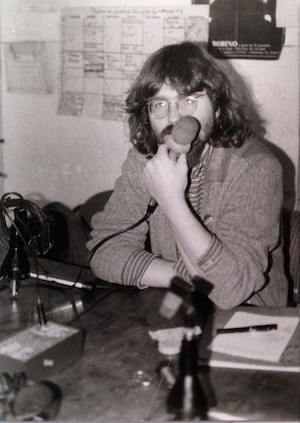
With the pirate radio assault in full swing, being on air was fundamental – for an aspiring artist or DJ, it was literally one of the only ways to claim one’s existence – and some of the clandestine stations became reggae bastions, with legendary outlet Radio Ivre even playing over 20 hours of bleeding-edge dub and reggae a week and leveraging its friendship with Concrete Jungle’s boss to invite guests such as Errol Dunkley, Kiddus I and Erroll Bellott to sing live in the studio.
Vacassin’s dream was to have his own show on Radio Ivre, but there was one slight problem: “I was just this kid, nobody had even heard of me.” Overcoming his fear of being seen as a less-than because he wasn’t anywhere on the totem pole, he mustered up the courage to pay the station a visit sometime in 1981, armed with the record collection he had feverishly accumulated over the last three years. He would meet Guillaume, “one of the first Lingala toasters” and squeeze out a few contacts, but the Holy Grail – a show to call his own – remained elusive, and he went back to pounding to the pavement.
Ironically, his ticket in would come from a childhood pal from Garges. Like Vacassin, “Papa” Ange appreciated the odder things in life. He was training to be a dentist by day, but moonlighted as an art and philosophy critic for authorities like Art Press, Concepts and La Voix du Regard. And, like Vacassin, he was going through a period of soul-seeking. “I was working in prepress but felt intellectually dissatisfied in that line of work, and Ange was going through the same thing at dentistry school, so we would get together to talk about our obsessions,” says Vacassin. “I would tell him about Céline, Miller and reggae, and he would talk to me about avant-garde, even though I was a novice.”
Ange’s dorm in a 12th Arrondissement student residence was a bit of a flophouse, with a bunkmate who worked for Radio Berbère. When the pirates became regulated, the new rules dictated that a fledgling station had to maintain two frequencies to keep its license, and so Berbère created Radio Afrique, an empty vessel that only needed programming – which Ange and Vacassin were only too happy to provide.
Vacassin started off modestly with Sweet Sweet Jamaica, a show named in honor of a Clint Eastwood track, and moved on to a regular guest spot on Ange’s program, Black Man Time (a reference to I-Roy’s cut), which aired on Friday nights from ten to midnight. During a 1983 programming meeting, the duo suggested throwing soundsystem parties to help finance the tiny station. Vacassin had a hunch that this could be his long-awaited opportunity to put his name on something truly unique.
Radio Afrique agreed, but everything still needed to be done. Finding a location, for starters – one where loud music could be played at nighttime. Nightclubs, which would at first seem like the natural choice, were quickly ruled out: In early 1983, the illustrious English crew Sir Coxsone had played a set using its own system at avant-garde club Palace. Vacassin recorded his impressions of the evening in one of his countless notebooks:
In London, toasters are never in the spotlight. They generally officiate from behind a pack of their supporters from a corner of the room. Tonight’s selection is nothing crazy. I sense that they are trying to appeal to what they think are French tastes, with Bob Marley, Burning Spear and of course Musical Youth’s “Pass the Dutchie.” The toasts aren’t anything to write home about either: hypnotic, obsessive and insistent, but the sound is “massive”, with machine guns and chillingly dramatic “tut-tuts.” DIY speaker columns tower one and a half meters over the floor in various spots throughout the room... Around three in the morning, they have relegated the room to disco, funk and soul. We’re guessing the Palace asked them to cut their set short. Maybe this is all too… disconcertingly stripped-down for a French audience.
This last musing underscores one very important point, which he goes on to belabor: “Whenever nightclub owners hear the word ‘reggae’(and I know this from my dealings with the guys from the Gibus,) the same clichés come up: the hassles, the drugs, the out-of-control partygoers, cops showing up, etc. Our demographic was still largely mysterious to these establishments, and they could only think of the usual stereotypes: blacks, West Indians and Africans… the outcasts and the riff-raffs. Stoners, freeloaders and guaranteed trouble. For the layperson, ‘reggae’ rhymed with ‘Bob Marley,’ and that invariably meant ‘weed.’ Ergo, nightclubs were bad juju, and we needed to look further afield.”
In 1982, Vacassin had been in contact with Camille, a Haitian who was “in charge of a place that must have been some sort of overseas cultural center or maybe a former embassy, behind Gare du Nord.” Under a huge mural depicting a tropical landscape, a ragtag crew of Radio Ivre operatives, together with Vacassin and his pals, would test the waters with events such as the 400 watt-powered evening of May 1st, 1982, with “around a hundred people, with Guillaume as toaster and MC… It was encouraging, but not totally satisfying. And bullshit was never far behind.”
Undeterred, Vacassin and Ange called upon their Radio Afrique connections, among whom was Bébenne, who knew about a nearby room that a local organization sometimes lent the station. The intrepid duo set out on a recon mission – and were met with a chapel, which had been converted into an occasional rec center and meeting space for Portuguese and Berber community groups. It was the kind of youth club that has a community billboard and a bunch of children’s drawings as decorations, but also a 200-person occupancy load and interesting acoustics, too, with its hardwood and tiled floors and a sort of balcony two meters above the main room, where Vacassin envisioned putting the booth.
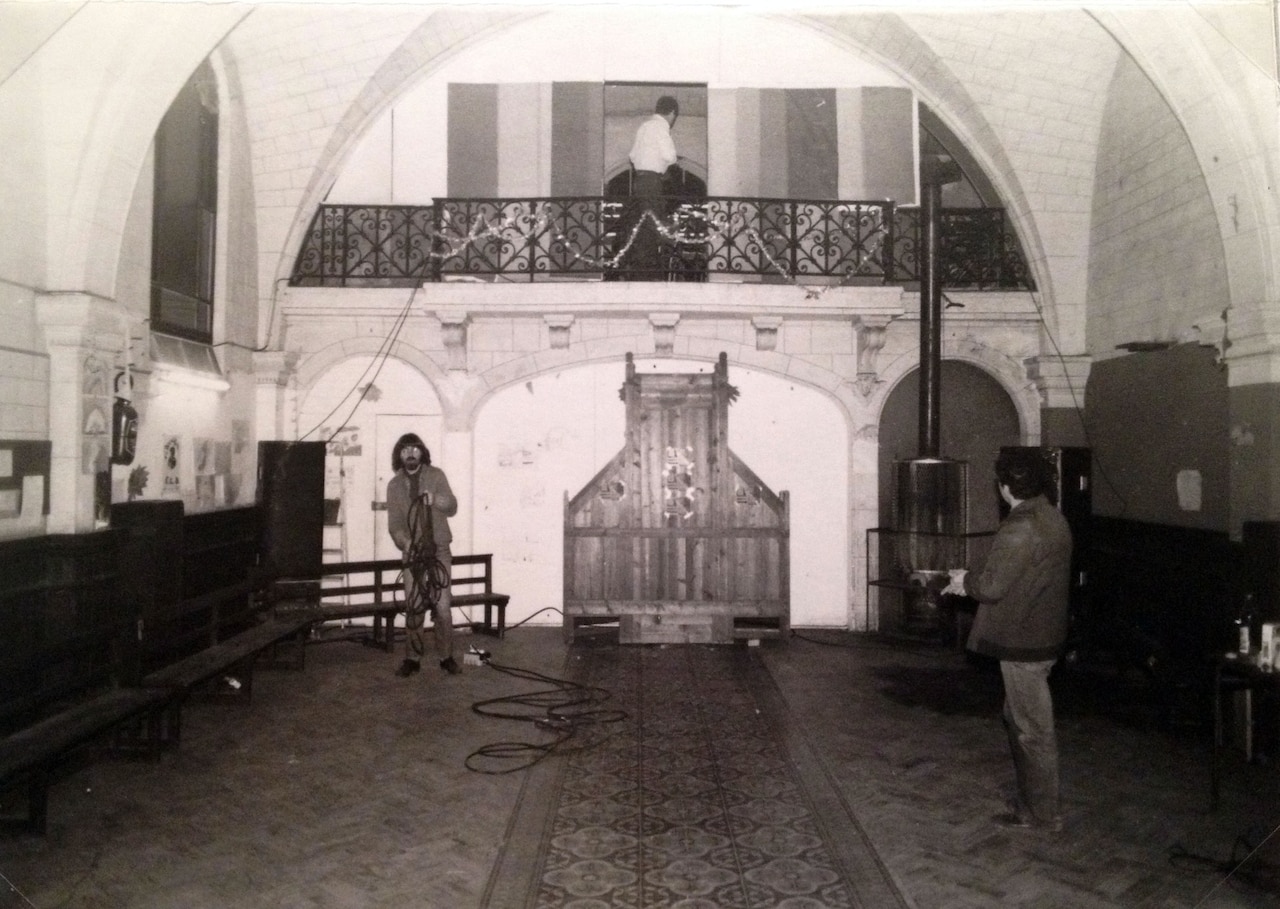
“The chapel is relatively out of the way, and Marie-Christine, who is in charge of the neighborhood association, assures us that we can be as loud as we want,” Vacassin noted in his diary at the time. Neighbors were few and far between, that part of Ménilmontant being, at the time, a bit of a wasteland. Presaging the contemporary gentrification, Vacassin took photographic documentation of the area’s “half-demolished housing projects and disused warehouses, houses that seem to be holdovers from another time, vacant lots and muddy construction sites, the crumbling pavements of the hilly side streets, the Arabic cafés with their dirty windows, the children’s finger-painting in the sooty walls…” before it all got completely overhauled.
The venue itself was a humble but promising affair, with a metallic door opening onto a paved courtyard surrounded by high walls and backing onto a vacant lot, with a shack on one side for a bar and the chapel on the right-hand side. Heaven.
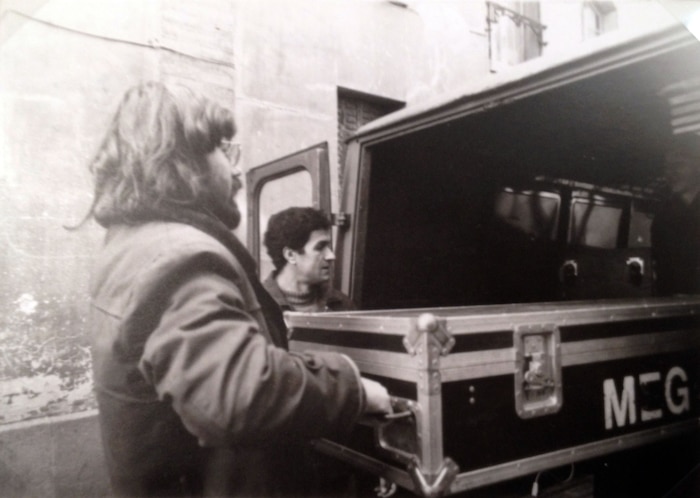
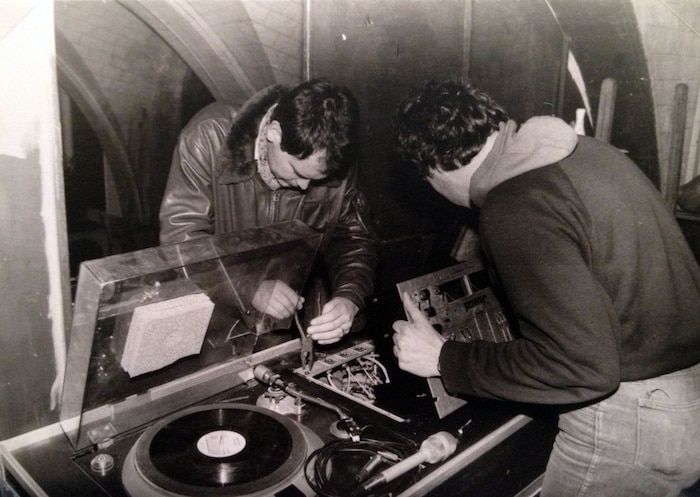
The motley crew’s baptism took place on February 19th, 1983, using a PA that Ange borrowed from Michel, a friend of a friend who had industry connections. For a delivery and installation fee of 600 Francs (about 90 euros), the gang got turntables, a mixer, a Yamaha echo chamber, two microphones and two 2 by 15-inch double wedges for the 2000-watt subwoofers.
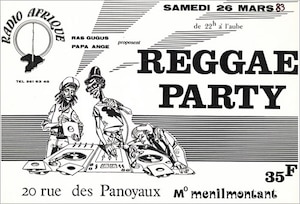
“We split the logistics according to our areas of expertise,” explains “Papa” Ange. “Didier was in charge of press relations, and I took care of the flyering and postering, because I was also a cartoonist – one poster took about a week to put together, and we spent nights pasting them around town, with Natty Marie (Marie Vaneetvelde) and Sister Pascale (Pascale Lemaître), who would also help us set up for the evening.”
“We gently pressured the radio station to upgrade the electrical – we even patched into the public transit network’s grid in order to ensure our PA got enough juice,” recalls Vacassin, who took the nickname Ras Gugus as a dual nod to the Negus – the Ethiopian royal title so dear to rastas – and to the corny French slang meaning something like “twat” – indicating with a touch of self-deprecation that he was very much aware of his own roots. He locked down all the permits and gave the cops his personal number, along with his assurance that he would be on-call to respond to the slightest problem. He conveniently forgot that the 10 PM mentioned on the flyer meant, in fact, “from 10 PM to sunrise.”
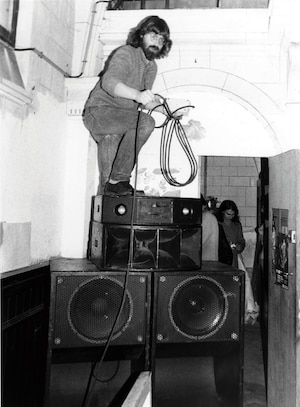
The event’s sound check was itself eventful. After a million tweaks, a Sugar Minott maxi finally sounded “just like home,” sending chills down Vacassin’s spine – and apparently blowing up the main fuse, just as people are about to start showing up. “In the end, it was nothing we did,” says Vacassin, “Just a neighborhood blackout that only lasted half an hour.” But as the lights came back on, more problems came up. “We asked Akim, one of the venue’s caretakers, to take us to the superintendent’s to ask him to turn the light on in the front booth, so we could set up the door person. Of course, the dude is completely wasted, barely able to stand, and he unceremoniously turned us down. So we gave up and set up candles, which actually gave the booth a kind of not-unwelcome rootsy vibe. So, people are starting to arrive, and are met with this wobbly table with candles all over it. The selectors and toasters had power, but the evening took place in pitch darkness. People were asking ‘Is this thing still happening? Is there power?’”
The event drew a fairly substantial crowd. Supposedly cutting-edge media types were there, and completely clueless. “Libération’s Philippe Conrath asked me who the headliners were. When I told him that we were going to be playing records, he said ‘I guess I’ll just write that there were bands’.” Thankfully, the “pirate” stations were there to spread the gospel. The booth was manned by Ras Gugus, of course, and Bernard “Burny” Bacos, who discovered the culture in Jamaica, was on mic duty, along with [Guillaume] “Iman Dread,” “who emulated Jamaican toasters quite well.”
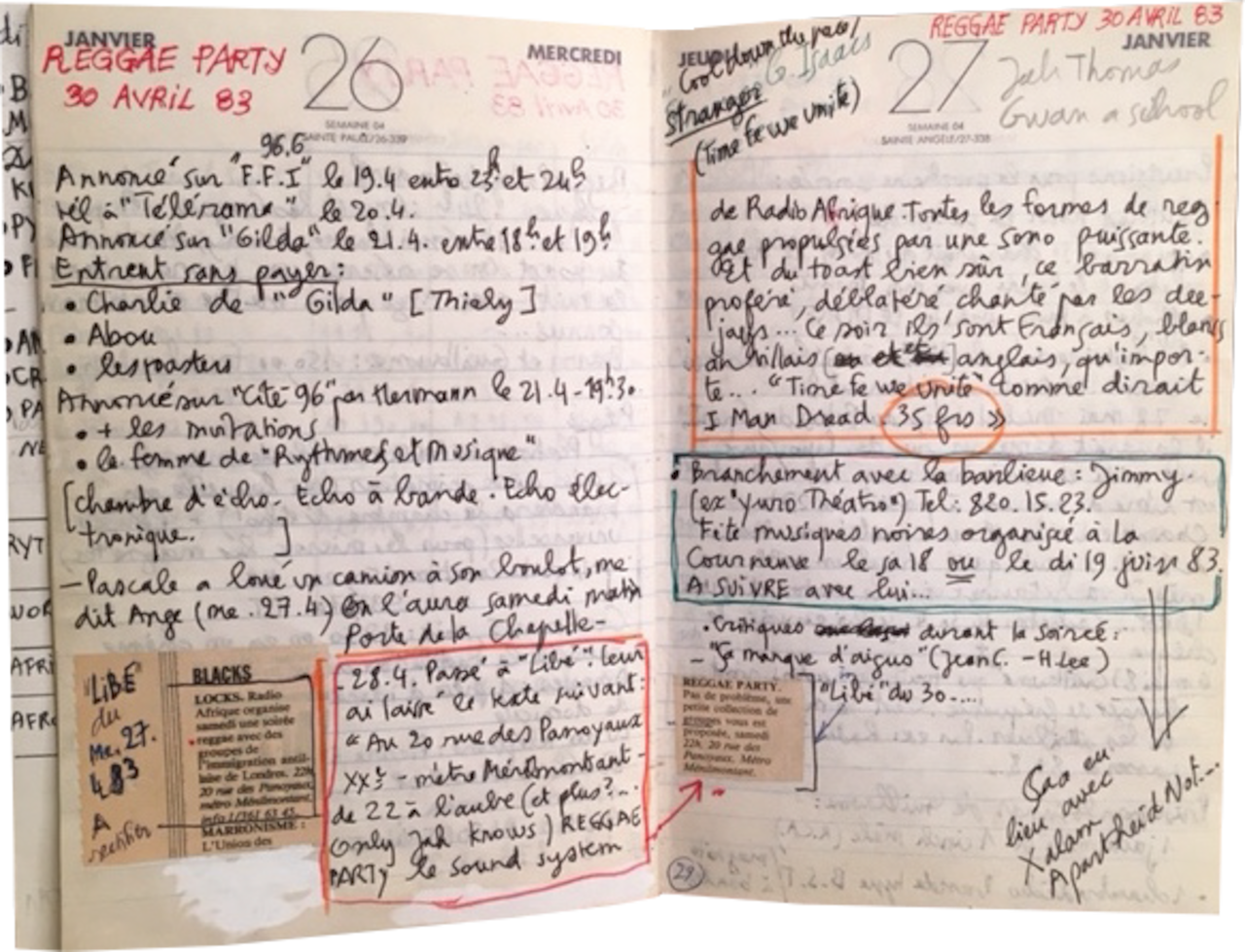
Toasting over tracks by the likes of U-Brown, Lone Ranger, Michigan & Smiley, Jah Woosh, General Echo and Yellowman, I-Man Dread and General Burny were actually booed as they attempted to weave bits of French into their riddim. “The first night’s vibe was a bit peculiar, the toasts seemed to divide the crowd – I guess because the toasters were two white dudes? And then we’d drop a Bunny Wailer, Mikey Dread or Tony Tuff maxi and everything was good again.”
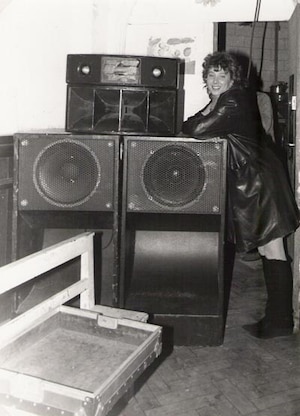
To avoid potential accusations of trying to establish a white-boy soundsystem, the organizers decided to recruit among the budding Caribbean toasters at the Rue de Flandres squat, kids like Jah Can or Ti’M and even some of French ragga’s future luminaries like Daddy Yod and Supa John (who would put on a memorable show during the last edition of the Panoyaux series). With experience setting in and word spreading, Vacassin’s parties started to draw a more diverse crowd, a true-to-the-times Parisian melting pot with a good dosage of hippies, punks, Caribbean expats and a smattering of trend-hoppers who were putting in their appearance on their way to some more prestigious meat market.
“Despite the inevitable putdowns, the thing caught on like a virus,” recalls Vacassin. “(American DJ) Satta Blue came by one night, as a spectator. God only knows what he thought of that mess. Another time, this Jamaican dude came out of nowhere, and, without even addressing anyone, grabbed the mic. He wouldn’t relinquish it, and even though he was a bit aggressive and slightly scary, he was quite good, so we let him. At the beginning, there was always a feeding frenzy for a bit of mic time anyway. Not far from the turntables, there were these chairs where the Adioa players would talk about bassline progressions while rolling joints off of 12-inch sleeves. Outside, people were gathering in the courtyard and in the vacant lot, talking, making connections. There was this kind of effervescence floating through the air, a distillation of quiet excitement, a kind of faith in what seemed to be on the horizon.”
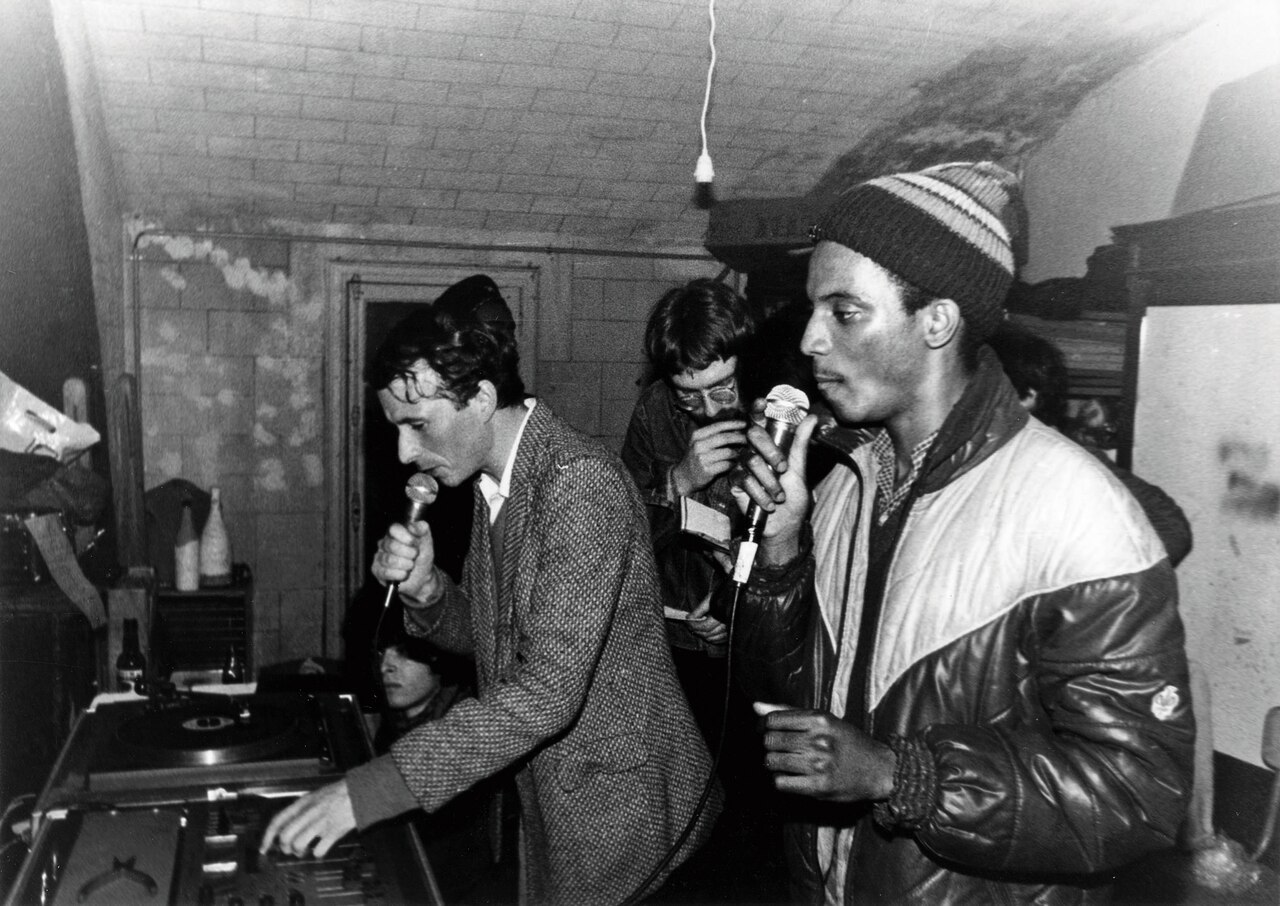
Despite the lack of a catchy, prepackaged image, any “stars” or a Bob Marley affiliate, the crowds ballooned to over 450 revelers, as Vacassin and Ange’s “Reggae Party Soundsystems” continued to be publicized by word of mouth. This would have continued had it not been for a simple, and quite banal, formality. While nowadays these types of event would eventually peter out because of the police (the Panoyaux soundsystems were legal and above-board), neighbors (a surly concierge cut the power to a part of the chapel one time), or internal tensions (there were zero fights or conflicts), in this case it was none of the above: Ange and Vacassin were told from the start that their venue was slated for demolition, and the wrecking ball came after the February 19th, March 26th, April 30th, May 28th and July 9th installments had run their course. Ménilmontant’s metamorphosis had hit its peak, and the chapel was summarily boarded up. Before its demolition two years later, it would have one last hurrah as the set of the 1986 movie Black Mic Mac, which told the story of a band of African griots and assorted squatters resisting a health inspector’s eviction attempts.
But as the movie hit the screens, Vacassin and Ange had moved on to the Quai de la Gare, where the former cold storage warehouses that once stood on the site of the current Bibliothèque Mitterrand served throughout the ‘80s as Paris’s foremost artistic cluster. Amid the hundreds of artists’ studios, a few kind souls were attempting to keep the Panoyaux experiment alive, with Vacassin half-heartedly helping out, having since moved on with Ange to the next stage in their grand vision: bringing a reggae dignitary to Paris, namely the London-based Jamaican singer/producer/DJ Mikey Dread. Lacking a business registration, they enlisted the help of a non-profit that left them high and dry, under circumstances that are shady to this day. On October 1st, 1983, they – and the 2,000 spectators waiting outside the venue – saw the event shut down by the police due to lack of permits. In spite of a flurry of phone calls to any and all authorities over the following 24 hours, no dice. “Those types of moments are hell to go through,” a still-traumatized Vacassin recalls. “Fiascos are never fun, but fiascos are also great learning experiences,” he concedes, 33 years on. “People’s attitudes are very edifying. For some people, in 24 hours, you just cease to exist.”
A major blow, but not a fatal one – for Gugus was back to being Vacassin, and in his usual wandering way, was already on to something else. Two years later, the first French raggamuffin 45s were in the bins, “classic” Parisian soundsystems had taken over and hit compilation Rapattitude made the genre a household name with its Daddy Yod and Tonton David cuts (“Rock en Zonzon” and “Peuples du Monde”). And since very few people remember their own baptism, the Panoyaux nights receded into the sands of time.
Header image © Didier Vacassin
